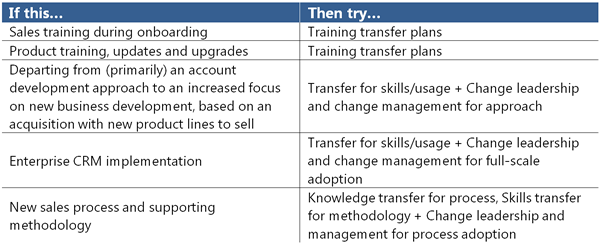ATD Blog
Ensure Sales Training Success with Change Leadership and Management – Part 1
Tue Aug 06 2013

Welcome back, sales enablers!
My daughter occasionally shops at Hot Topic. Every time I’m forced to veer in there, I amuse myself by making bad puns (in my head, of course), about what I perceive as real hot topics, like global economic issues, unemployment, healthcare regulations, or perhaps…making significant investments in sales training without any adoption, sustainment, or change plans.
Oops. That last one hits a little too close to home, doesn’t it?
In my recent series of posts on the Sales Performance Ecosystem and follow-up posts on selecting and prioritizing sales enablement solutions (Part 1 and Part 2), I promised I’d talk next about change management and change leadership. Let’s start by defining those terms.
Change what you think about change
Much has been written about the difference between management and leadership. Unfortunately, it’s often at the expense of management, with leadership being touted.
In reality, both are required to run an organization effectively. Some say leadership and management are both skill sets that can be learned; others posit that you can’t be both a leader and a manager. Many leadership experts have astute and varying viewpoints. There’s similarity, of course, but everyone has a somewhat different take. To capture the essence of the difference between management and leadership, I’ve always liked Peter Drucker’s simple quote: “Management is doing things right; leadership is doing the right things.”
I define change leadership as:
developing the over-arching vision (“here’s what we want to be”) and direction (“so take that hill! charge!”)
forging the connection between the vision, strategy, critical business initiatives, and people’s roles (the power of “connecting dots” simply can’t be overstated)
changing the conversation at all levels to motivate and inspect the change (you move people with language and stories – or for Aristotle fans – with ethos, pathos, and logos).
modeling and reinforcing the messages (awareness) and the urgency consistently, with discipline (not “flavor of the month” but the “flavor of our future”).
I think of change management as:
delivering the same consistent messaging as leadership, to sustain awareness and urgency at frontline levels, where the work with customers occurs
implementing processes, programs, and directives to support the change and new desired state
following a plan to meet milestones of measurement and achievement (project management)
engaging the entire workforce with “what to do and how to do it” (since they already know “why” from the messaging)
Here are some resources on the distinctions between change leadership and change management:
Peter Drucker on Leadership – Forbes
Change Management vs. Change Leadership - What's the Difference? – John Kotter
Why Change Management? – Prosci.
Should you always orchestrate a full-fledged change initiative?
This is the big question, right? The real question is whether you really need to drive full-scale change and sustainment or simply foster transfer and adoption. (By the way, “simply” in this case does not mean “easy.” Although, it may be “easier” in comparison.)
Training transfer (or what I like to call “planned transfer”) includes plans to get the training out of the learning environment and used on the job. In Kirkpatrick Level 3, this is “Application.”
The goal of transfer is often a deeper level of adoption…not just being able to demonstrate the skills and use them on-the-job, but to adopt them consistently, in the right circumstances. Adoption occurs as a learner moves through the stages of learning toward mastery (conscious incompetence to conscious competence to unconscious competence).
Change and sustainment efforts are required when you need behavior changes at multiple levels in the organization, in order to achieve strategic goals (make money, save money, manage risk) and need the change to stick.
As always, specifics vary by context and circumstance, but here are some examples of what I mean:

Make sense? Here are some factors that we guide clients to consider at Richardson. Consider a change initiative when:
“Behavior change” will be a key element of achieving ambitious goals over the next eight years.
The key to this change is not only what’s done in the learning environment, but in the adoption and reinforcement afterward.
You are asking every level of leader to change behaviors in a significant way.
Leaders must actively engage at all levels to drive and sustain the behavior changes with staff.
Which methodologies should I use?
Okay, so you’ve decided that you need to really guide a major change in your organization. Now what?
I’ve used a variety of methodologies over the years and will link to some others at the end of Part 2, but I’ve gotten to know Prosci’s ADKAR® methodology recently and like it quite a bit. My employer uses it internally and with clients, with great success.
ADKAR® is:
Awareness of the need to change
Desire to participate in the change
Knowledge of how to do things differently
Ability to apply tools, processes, and knowledge
Reinforcement to sustain personal efforts to change despite setbacks.
Here is some additional information about ADKAR® which should enable anyone who’s interested to learn much more about this well-researched and proven approach:
Leading Your Sales Organization Through a Change Management Program – Gregg Kober of Richardson on ADKAR
Change Management Learning Center - ADKAR Tutorial – Sponsored by Prosci
ADKAR: A Model for Change in Business, Government and our Community – Paperback on Amazon
Part 1: A Practical Approach to Change Management – YouTube video on ADKAR (9 minutes) Part 2: A Practical Approach to Change Management – YouTube video on ADKAR (12 minutes). I’ll stop here for now and pick up next time to share some specific differentiating elements that we’ve found very effective, such as the Change Story Framework, the P + P + A + S > R formula, and Adoption Questions. Until then, happy enabling!
You've Reached ATD Member-only Content
Become an ATD member to continue
Already a member?Sign In
